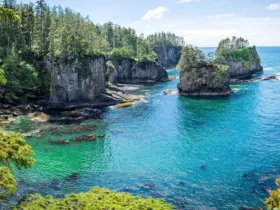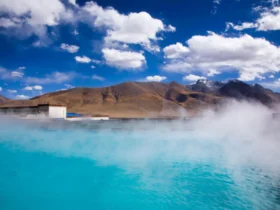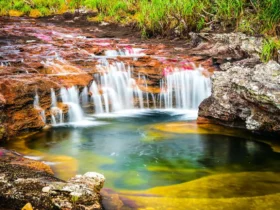Lake Nakuru is a beautiful freshwater lake located in the Rift Valley of Kenya, East Africa. It is one of the most famous lakes in Kenya and an important tourist destination.

Here is some information about Lake Nakuru
Lake Nakuru is a natural gem in Kenya, renowned for its flamingos, diverse wildlife, and breathtaking scenery. It attracts nature lovers, photographers, and wildlife enthusiasts from around the world, providing a memorable experience in the heart of East Africa.

Location & Size
Lake Nakuru is situated in Nakuru County in central Kenya. It is located within Nakuru National Park, approximately 160 km northwest of the capital city, Nairobi. Lake Nakuru covers an area of about 45-50 square kilometers. It is a shallow lake, so its depth varies depending on the season.

Water source and ecosystem
Lake Nakuru is a soda lake with alkaline and saline water. This creates favorable conditions for the growth of algae, particularly spirulina algae, which is a primary food source for millions of flamingos and other water birds. Additionally, the lake supports diverse wildlife, including fish, pelicans, deer, and other wild animals.

Flamingo Migration
Lake Nakuru is famous for its massive gatherings of flamingos, which create a stunning pink hue along the lake’s shores. The flamingos are attracted to the lake due to the abundance of algae, their primary food source. The number of flamingos can vary throughout the year depending on food availability and other factors.



Rhinoceros Sanctuary
Lake Nakuru National Park is recognized as a sanctuary for both black and white rhinoceroses. The park’s conservation efforts have been successful in reviving the rhino population, making it an important location for rhino conservation in Kenya.

Other Wildlife
Lake Nakuru National Park is home to a rich variety of wildlife beyond flamingos and rhinos. Visitors may spot other animals such as lions, leopards, baboons, vervet monkeys, warthogs, waterbucks, and various bird species, including eagles, herons, and pelicans.


Conservation
Lake Nakuru and its surrounding area have been designated as a national park to protect its unique ecosystem and wildlife. The park is home to a variety of wildlife, including rhinos, giraffes, zebras, and numerous bird species.

Wildlife Conservation
Lake Nakuru National Park, which encompasses the lake and its surroundings, is a protected area known for its efforts in wildlife conservation. The park is home to a wide range of animal species, including black and white rhinos, buffaloes, giraffes, zebras, antelopes, and various bird species. The park plays a vital role in the conservation of endangered species, particularly the rhinoceros.

Scenic Landscapes
Apart from its abundant wildlife, Lake Nakuru offers stunning scenic beauty. The lake is surrounded by picturesque landscapes, including rolling hills, acacia forests, dense forests, grassy plains, and rocky cliffs, providing a picturesque backdrop for wildlife viewing and photography.

Visiting Lake Nakuru
The lake and the national park offer opportunities for game drives, bird-watching, nature walks, and picnicking. Visitors can enjoy the beauty of the lake, observe wildlife in their natural habitat, and appreciate the rich biodiversity of the region.


At Lake Nakuru, there are several activities and attractions that visitors can enjoy.
- Game Drives: Embark on a thrilling game drive through Lake Nakuru National Park. Explore the park’s diverse landscapes and encounter a wide variety of wildlife, including rhinos, buffaloes, giraffes, zebras, antelopes, lions, leopards, and more. Game drives offer an excellent opportunity to observe animals in their natural habitat and capture memorable photographs.
- Bird-Watching: Lake Nakuru is renowned for its birdlife, particularly the large flocks of flamingos. Bird-watchers can spot numerous species of birds, including pelicans, eagles, herons, storks, and a wide range of water birds. The lake is a paradise for ornithologists and bird enthusiasts.
- Rhino Sanctuary: Visit the rhinoceros sanctuary within Lake Nakuru National Park. Learn about the conservation efforts aimed at protecting these endangered species. Witness both black and white rhinos in a protected environment, contributing to their preservation and survival.
- Picnicking and Relaxation: Take advantage of the park’s picnic sites and enjoy a leisurely lunch surrounded by nature. Many areas within the park offer beautiful views and tranquil settings, allowing you to unwind and soak in the peaceful atmosphere.
- Hiking and Nature Walks: Explore the park on foot by taking guided nature walks or hikes. This allows you to appreciate the smaller details of the ecosystem, learn about the flora and fauna, and enjoy the serenity of the surroundings.
- Photography: Lake Nakuru offers stunning landscapes and wildlife, making it a paradise for photographers. Capture breathtaking shots of the lake, the diverse wildlife, the flamingos in their vibrant colors, and the picturesque scenery of the national park.
- Visit the Viewpoints: Lake Nakuru National Park features several viewpoints that offer panoramic vistas of the lake, the surrounding landscapes, and the wildlife. These viewpoints provide excellent opportunities for sightseeing, photography, and taking in the natural beauty of the area.


Lake Nakuru can be visited throughout the year, but the best time to visit may depend on your preferences and interests.

- Dry Season (January to March, June to October):
- This is considered the peak tourist season at Lake Nakuru.
- The weather is generally dry, with less rainfall and clearer skies.
- Wildlife sightings are excellent during this time, as animals gather around the lake and in search of water sources.
- Bird-watching is particularly rewarding, as the flamingos are usually abundant and active.
- Wet Season (April to May, November to December):
- These months experience the rainy season in the area.
- The landscape becomes lush and green, and the park is less crowded.
- It’s a great time for bird-watching, as migratory bird species arrive during the wet season.
- The scenery is beautiful, with vibrant colors and fresh vegetation.
- However, some areas of the park may be inaccessible or muddy due to the rains.

Lake Nakuru offers a captivating blend of stunning landscapes, abundant wildlife, and remarkable birdlife, making it a must-visit destination for nature enthusiasts and wildlife lovers. Whether it’s the iconic flamingos, the thriving rhino population, or the scenic beauty of the park, Lake Nakuru provides a memorable experience in the heart of Kenya’s natural wonders.

Ultimately, any time you choose to visit Lake Nakuru will offer unique experiences and the opportunity to witness the incredible wildlife and natural beauty of the area. We look forward to seeing you in upcoming articles!





